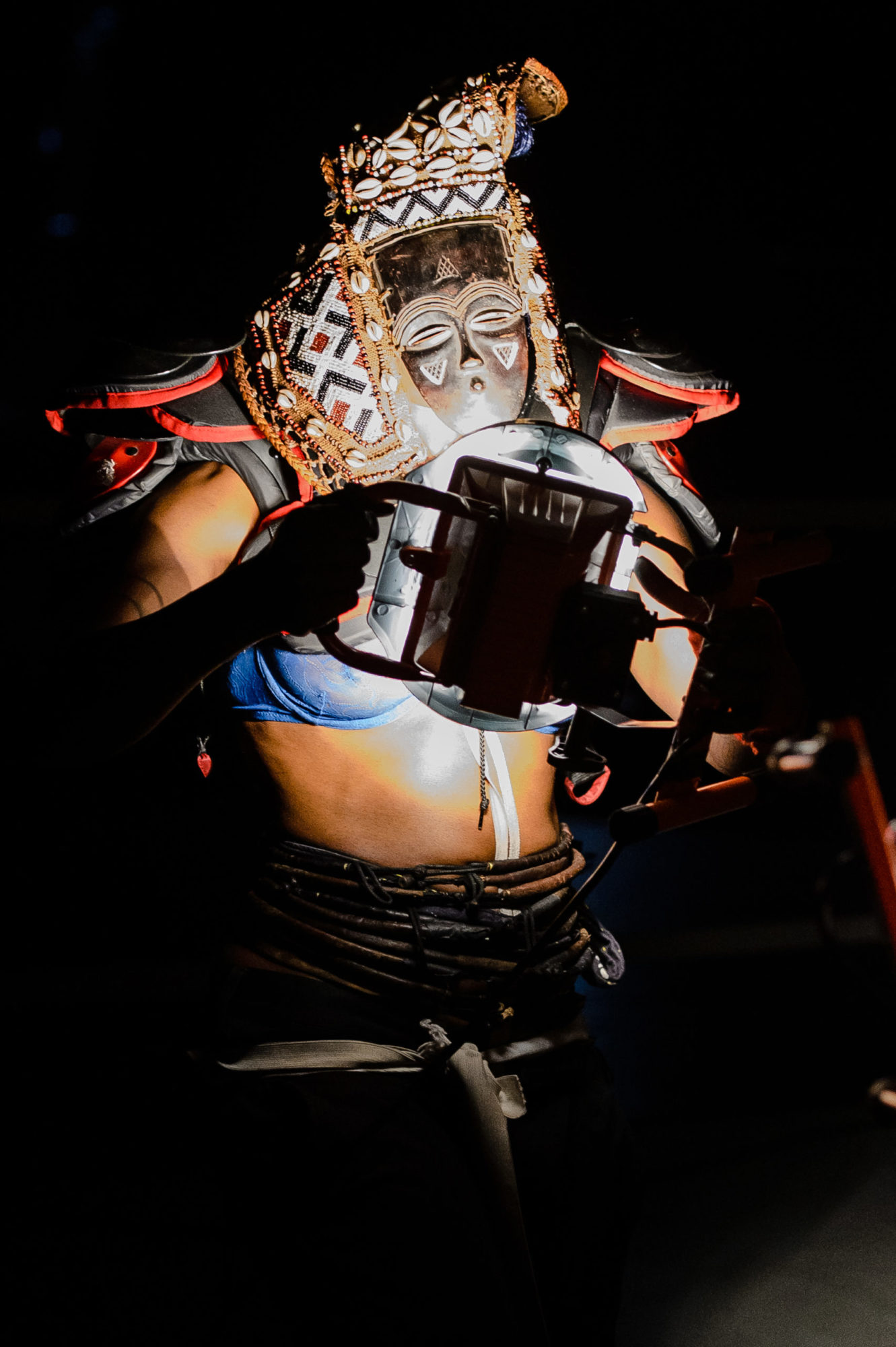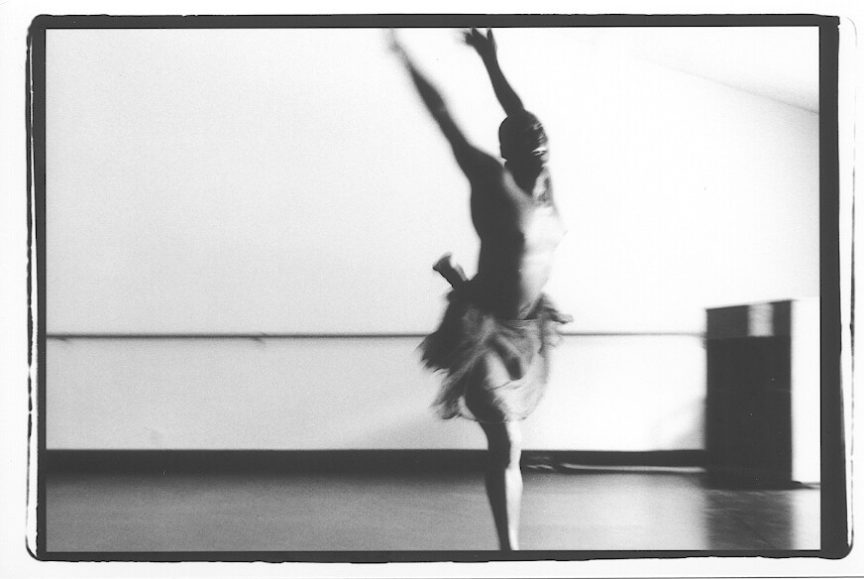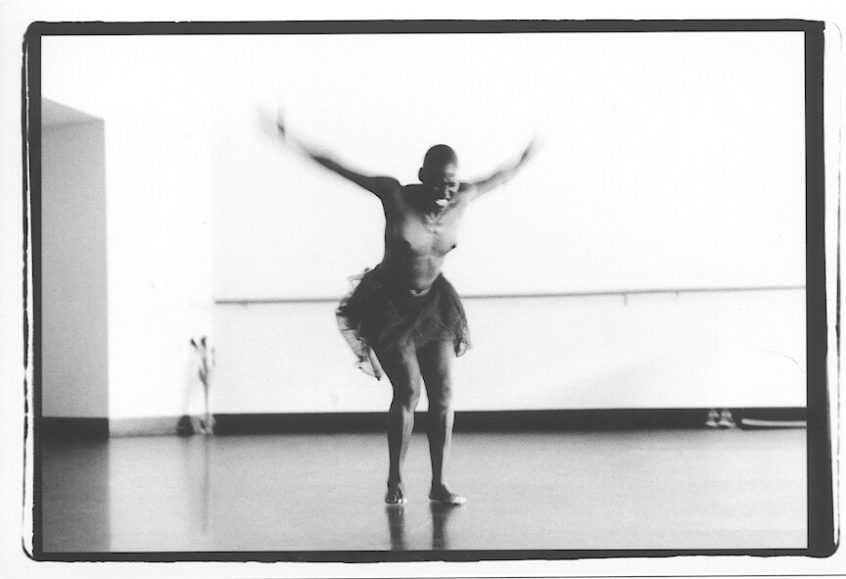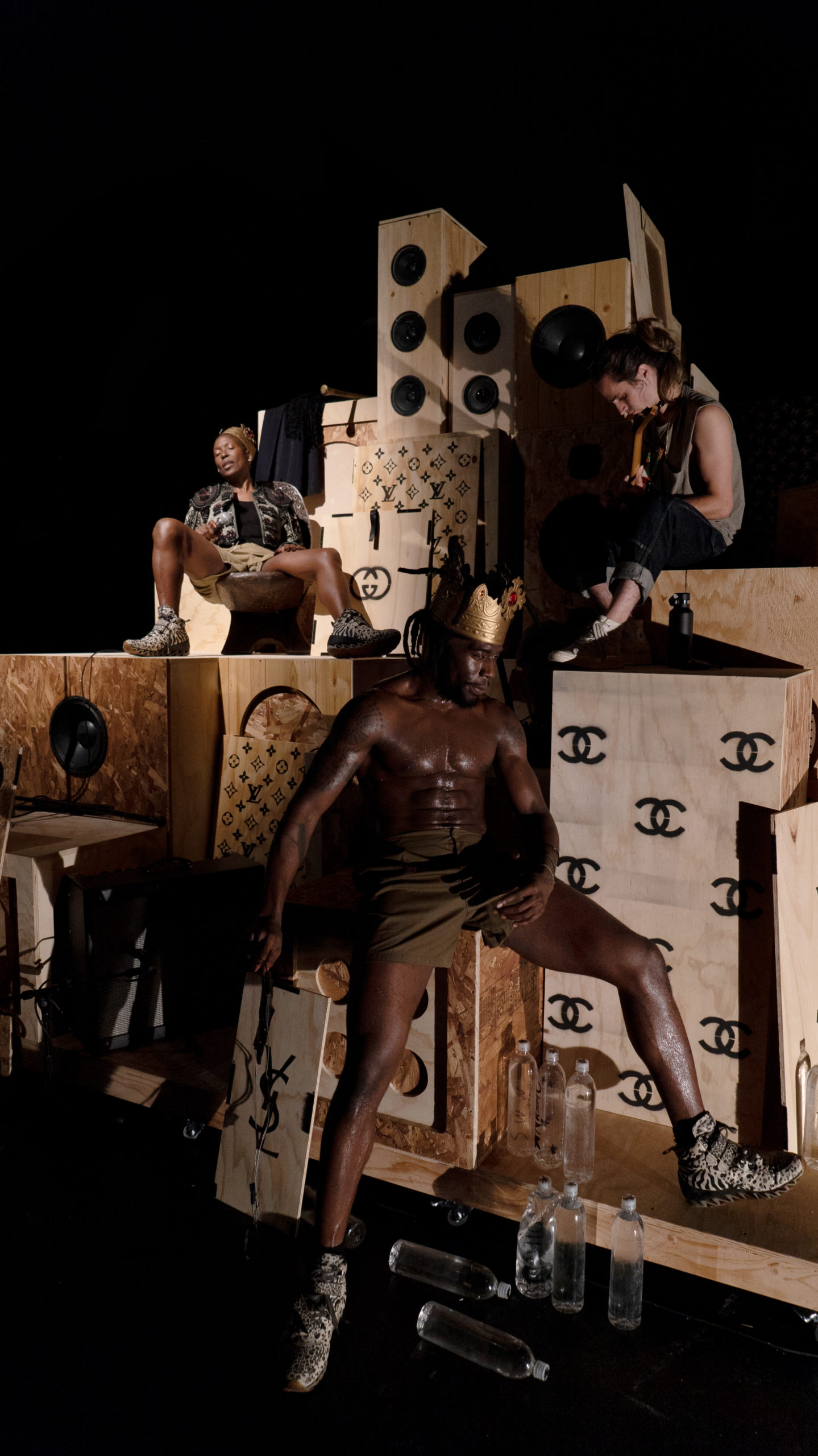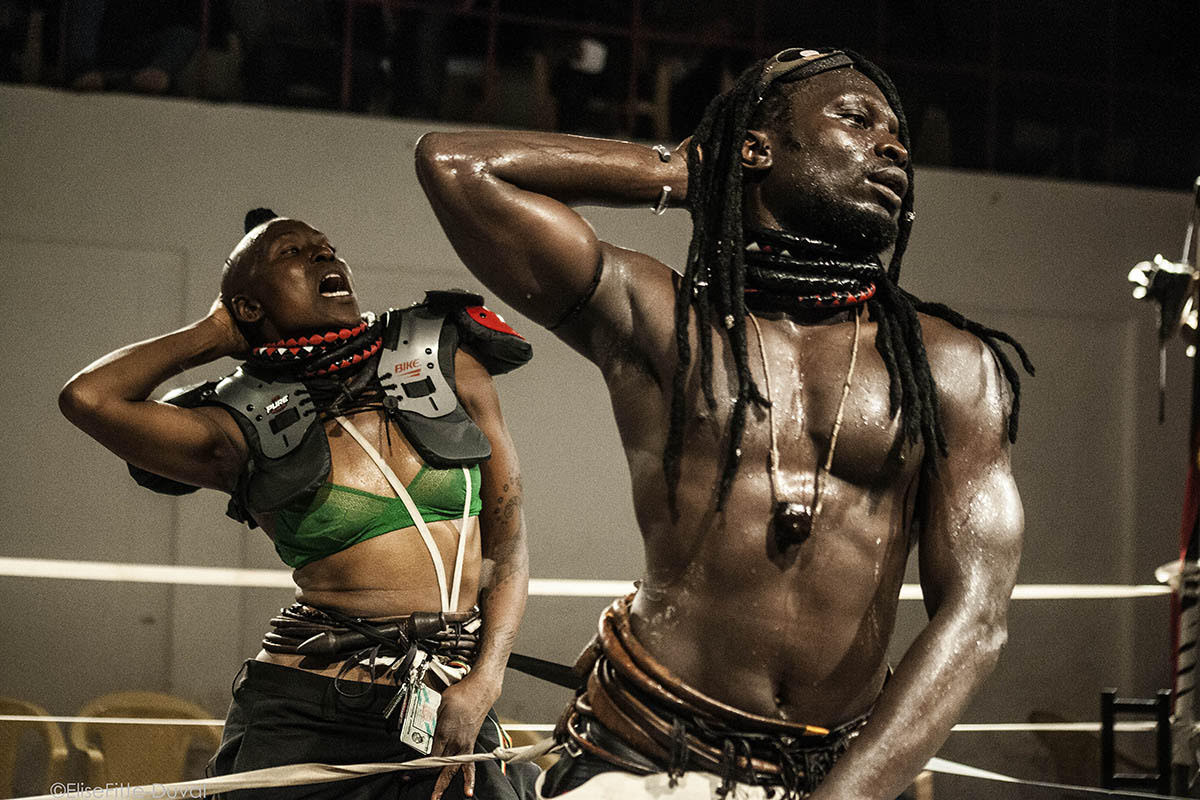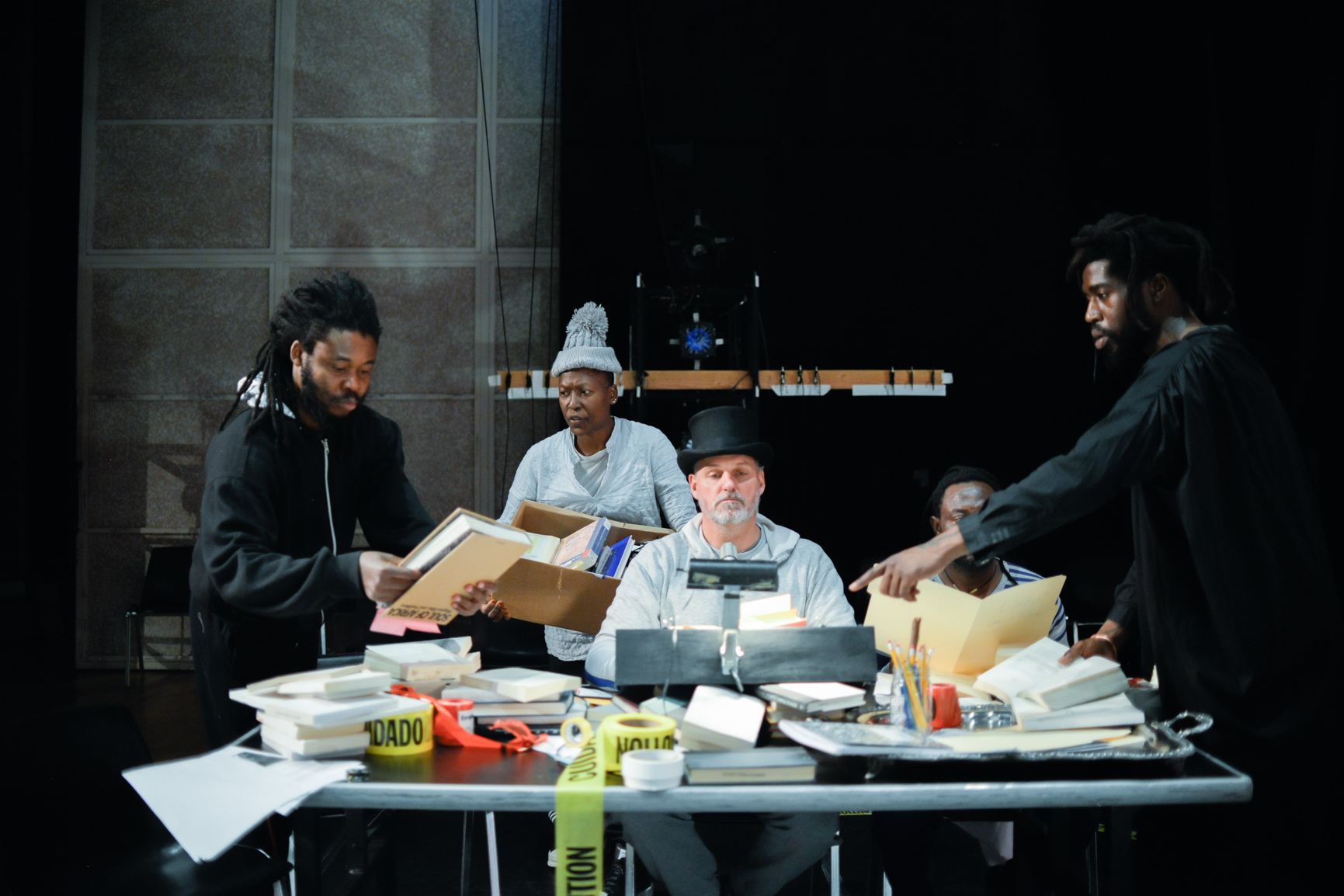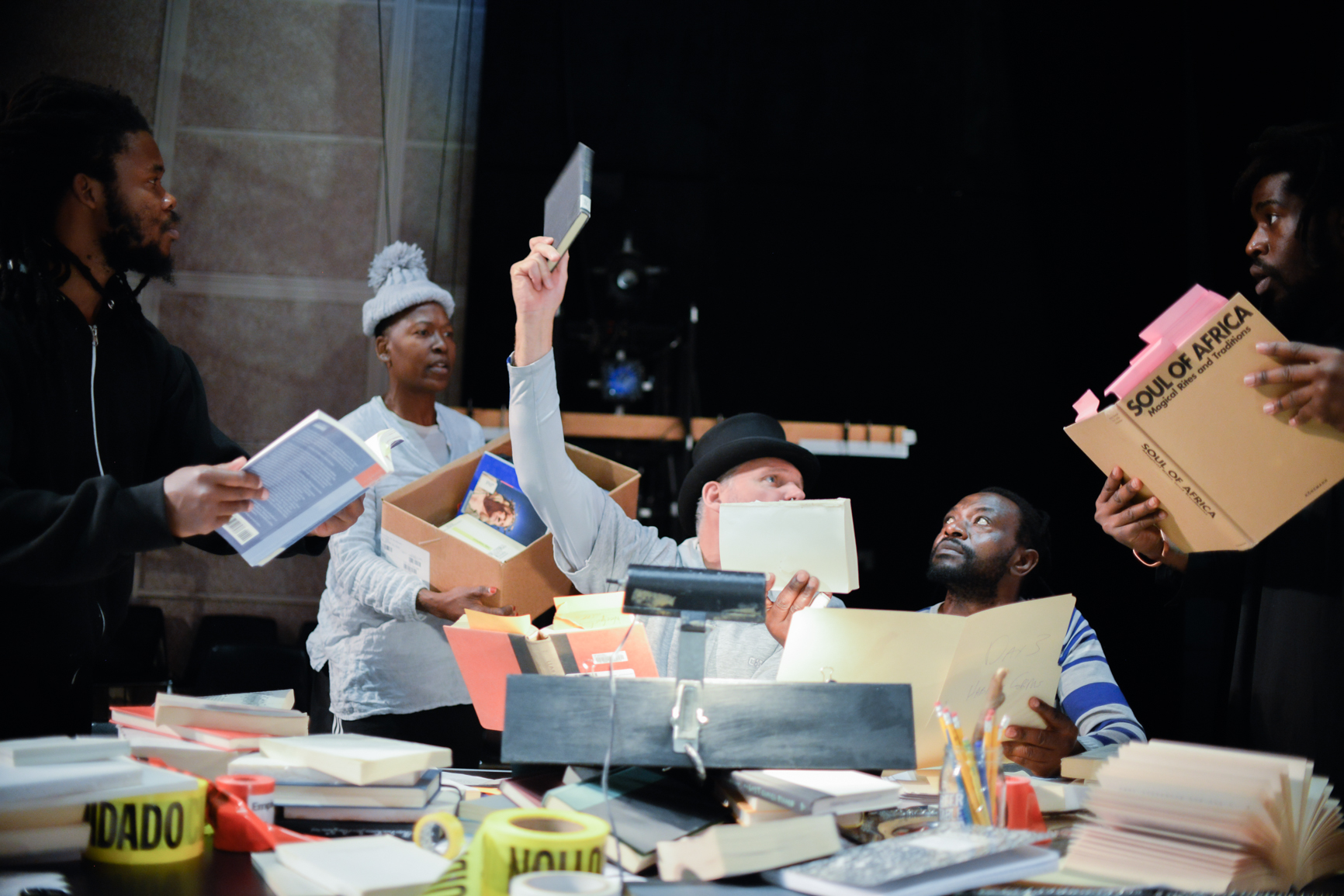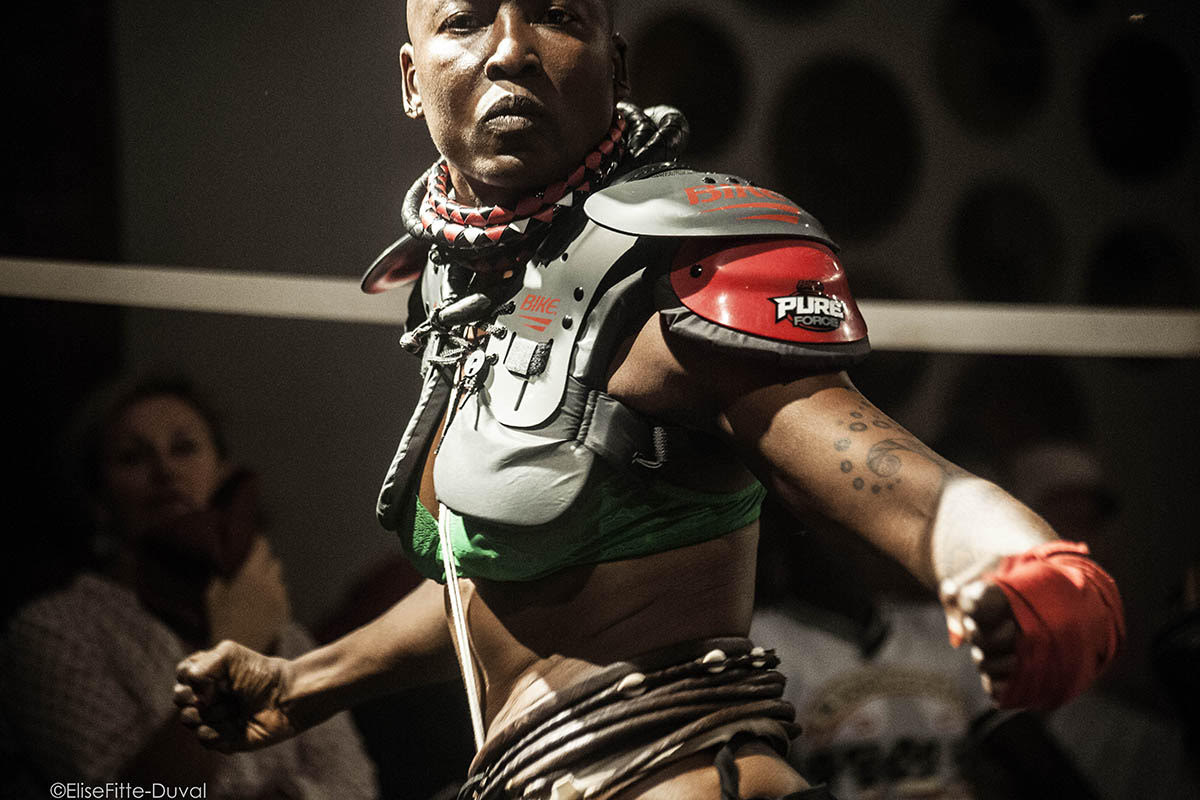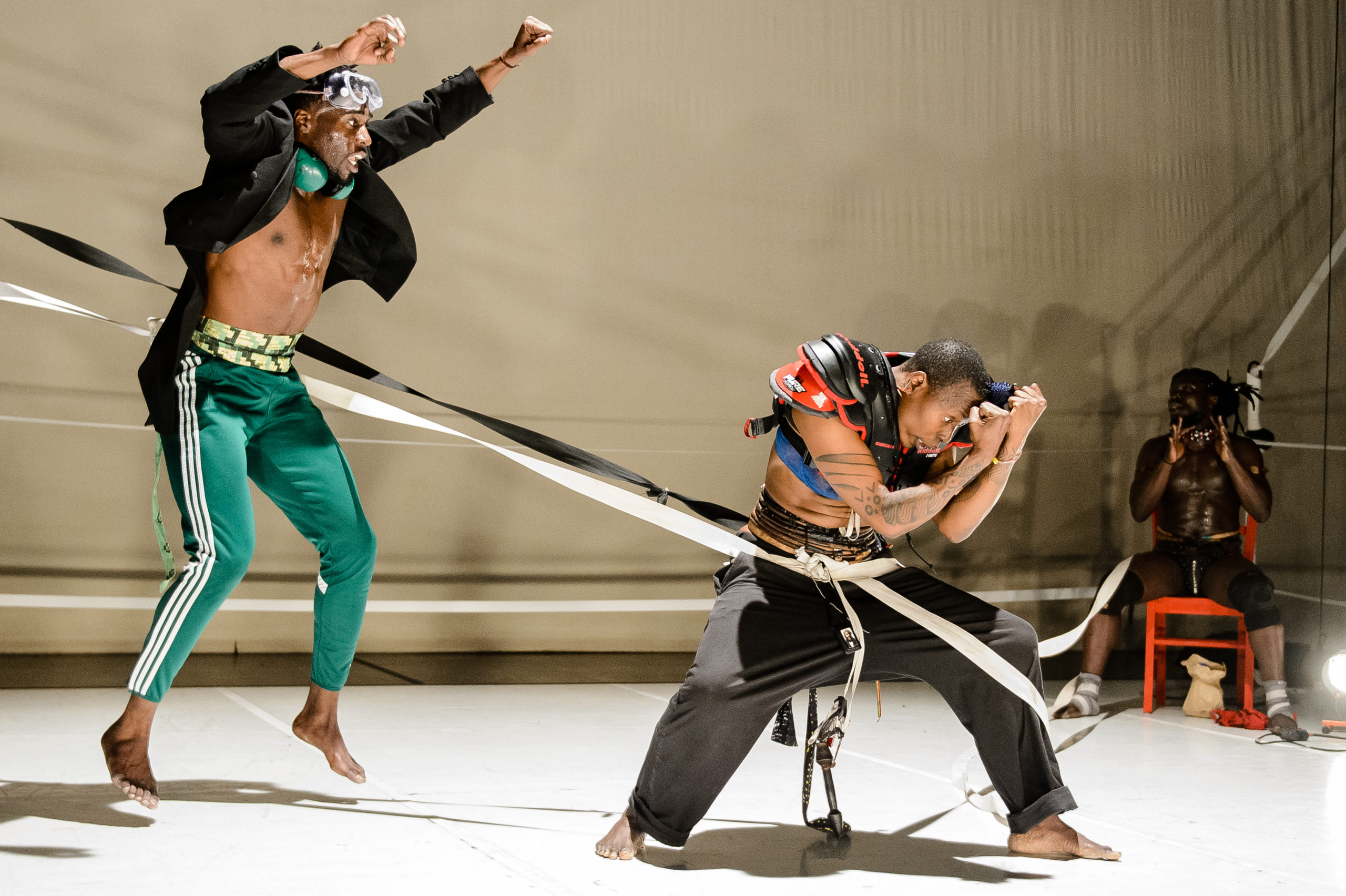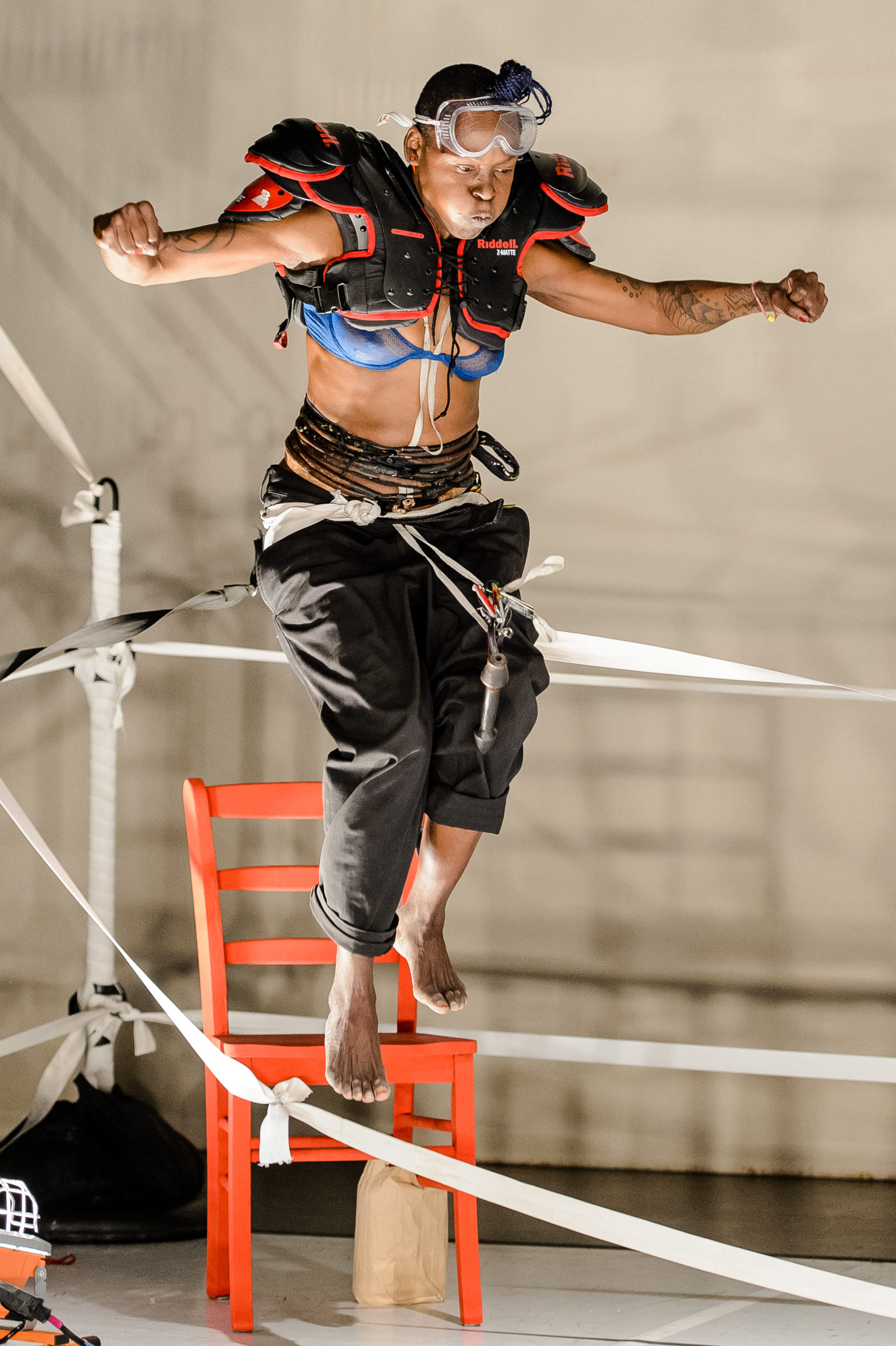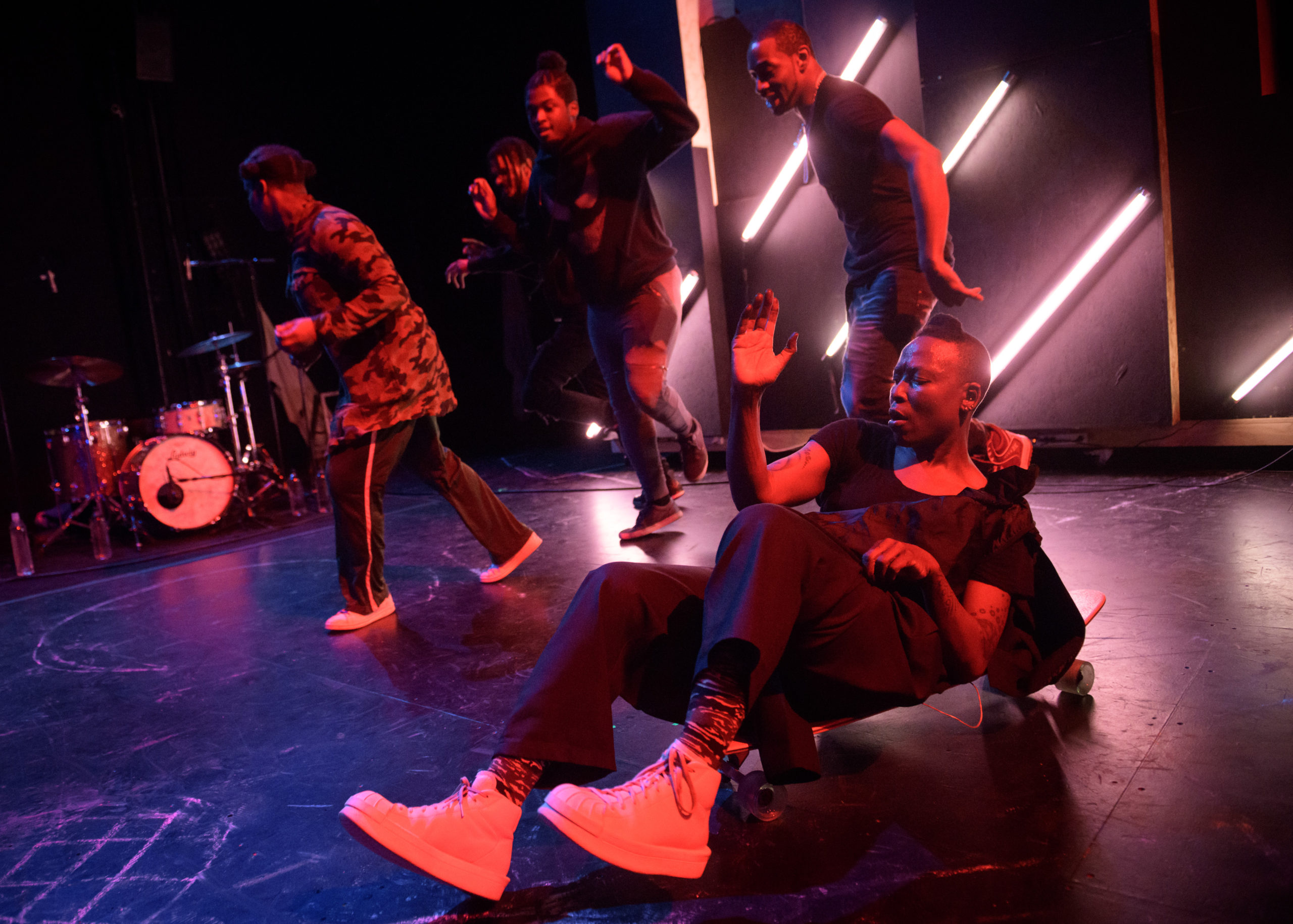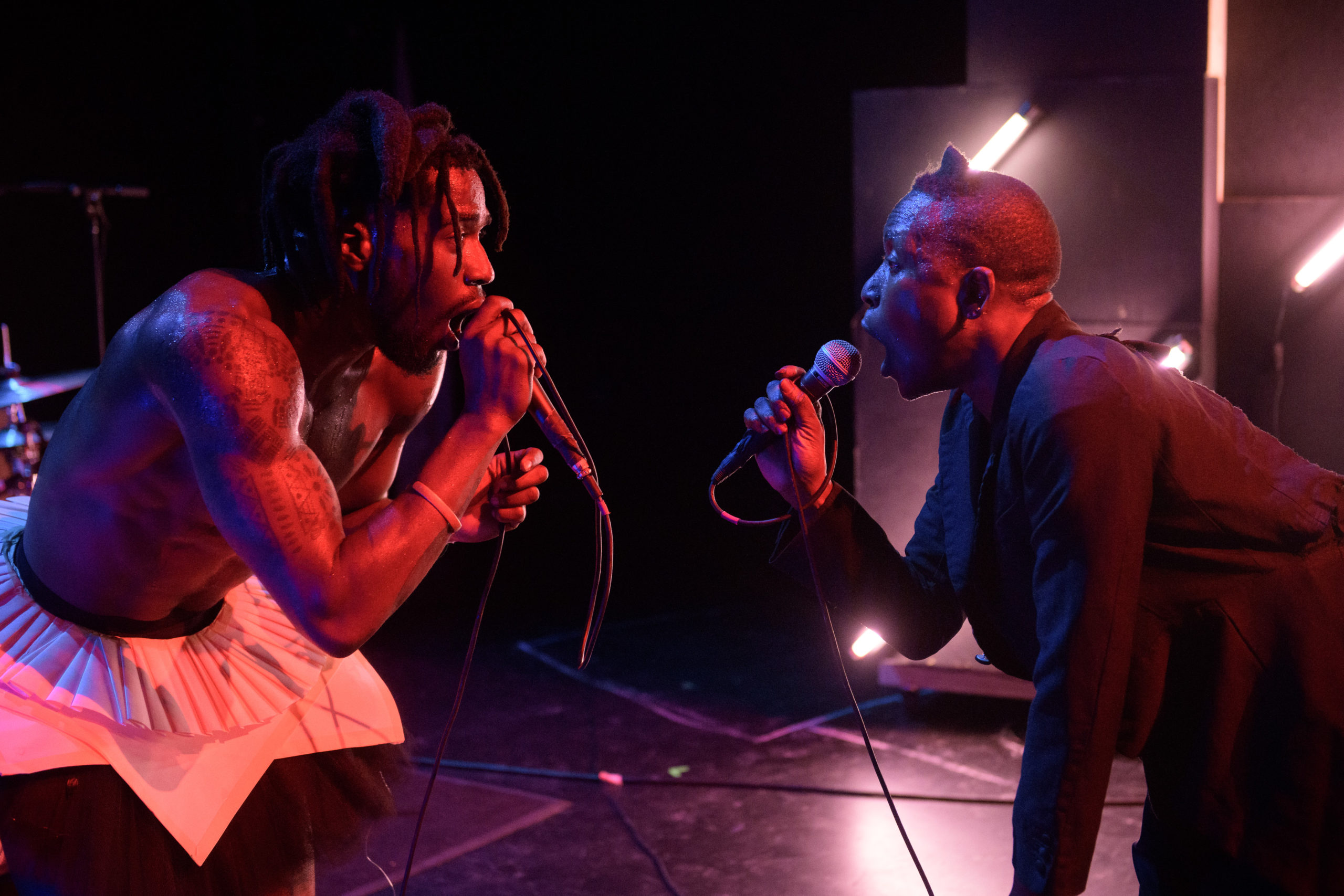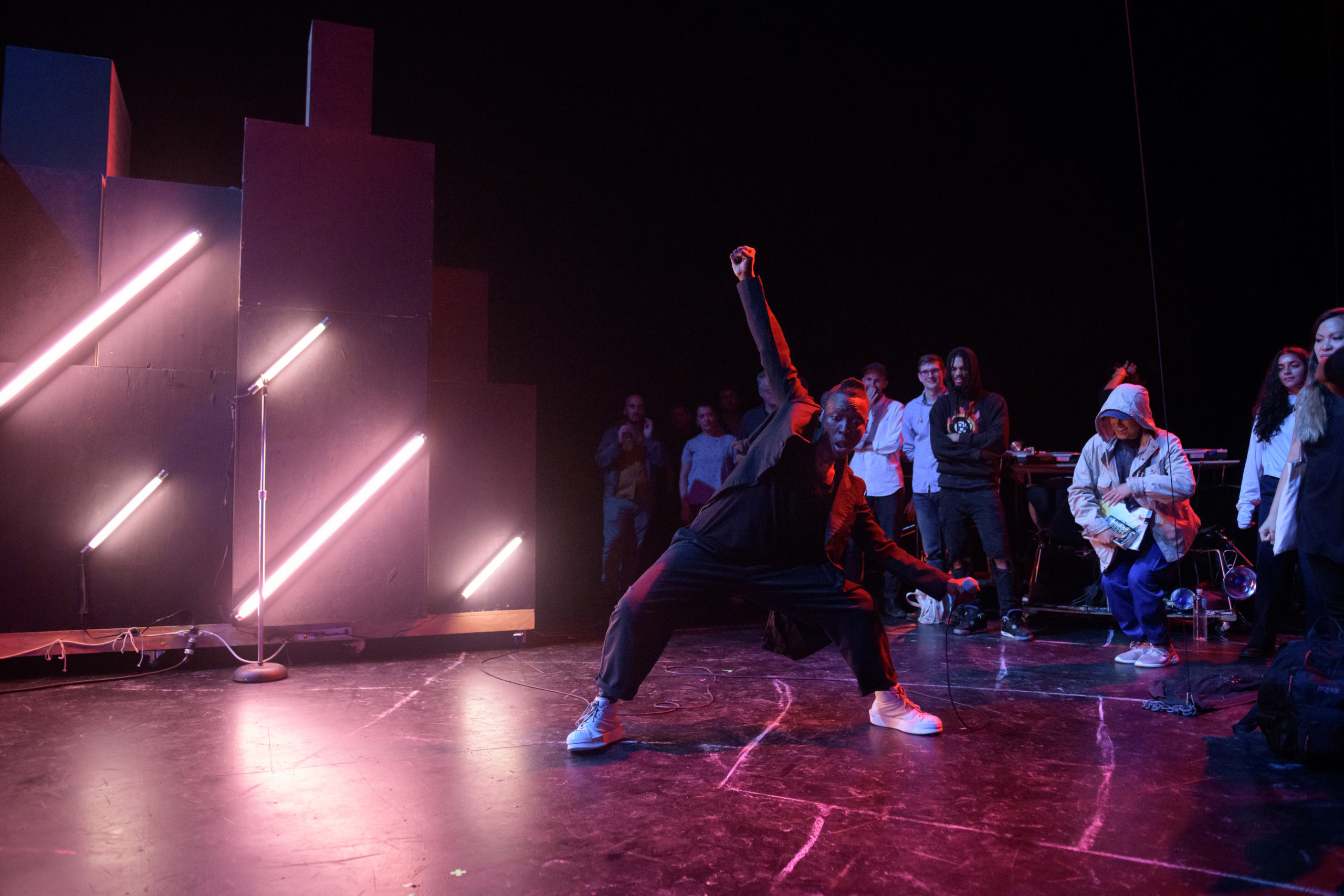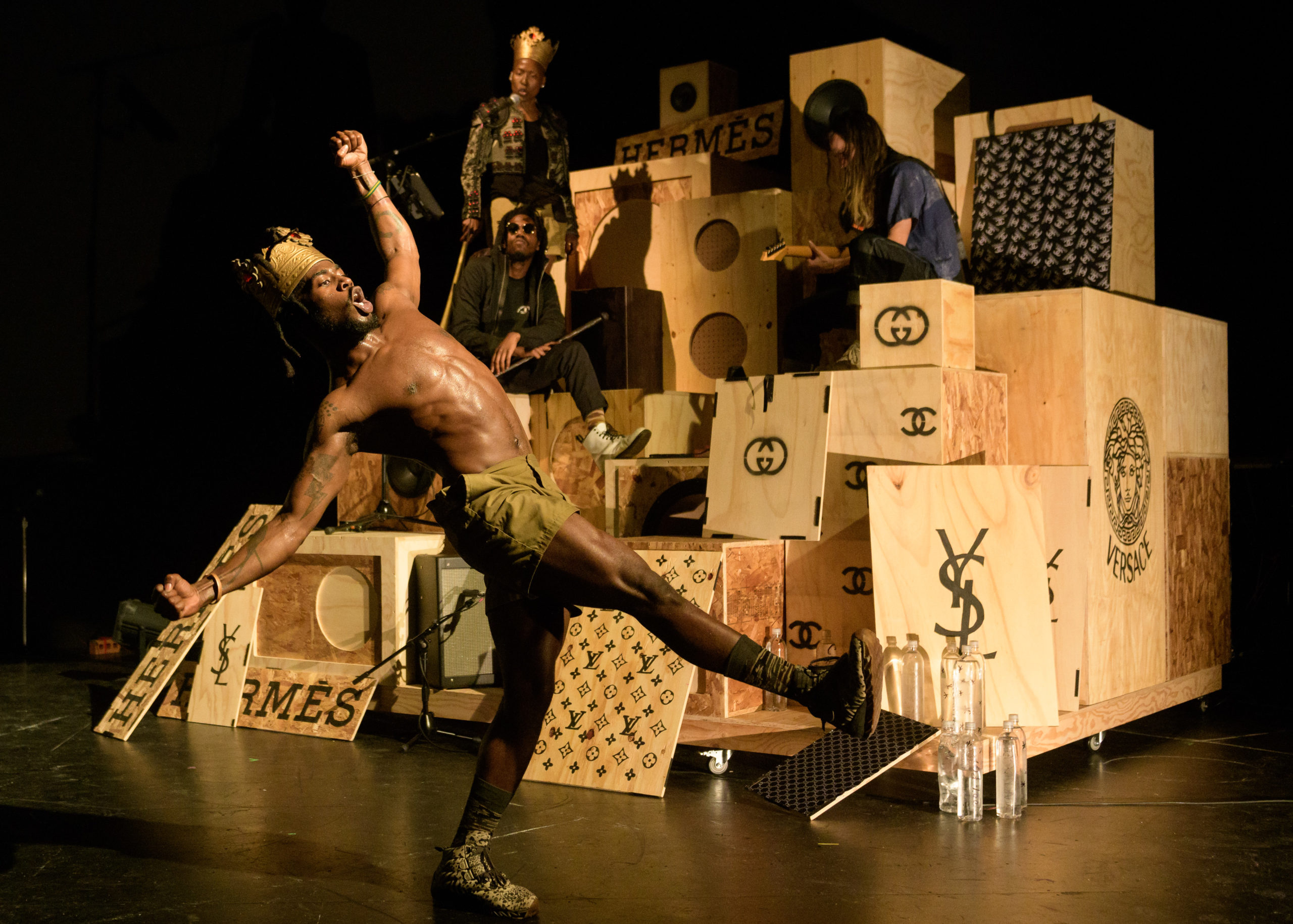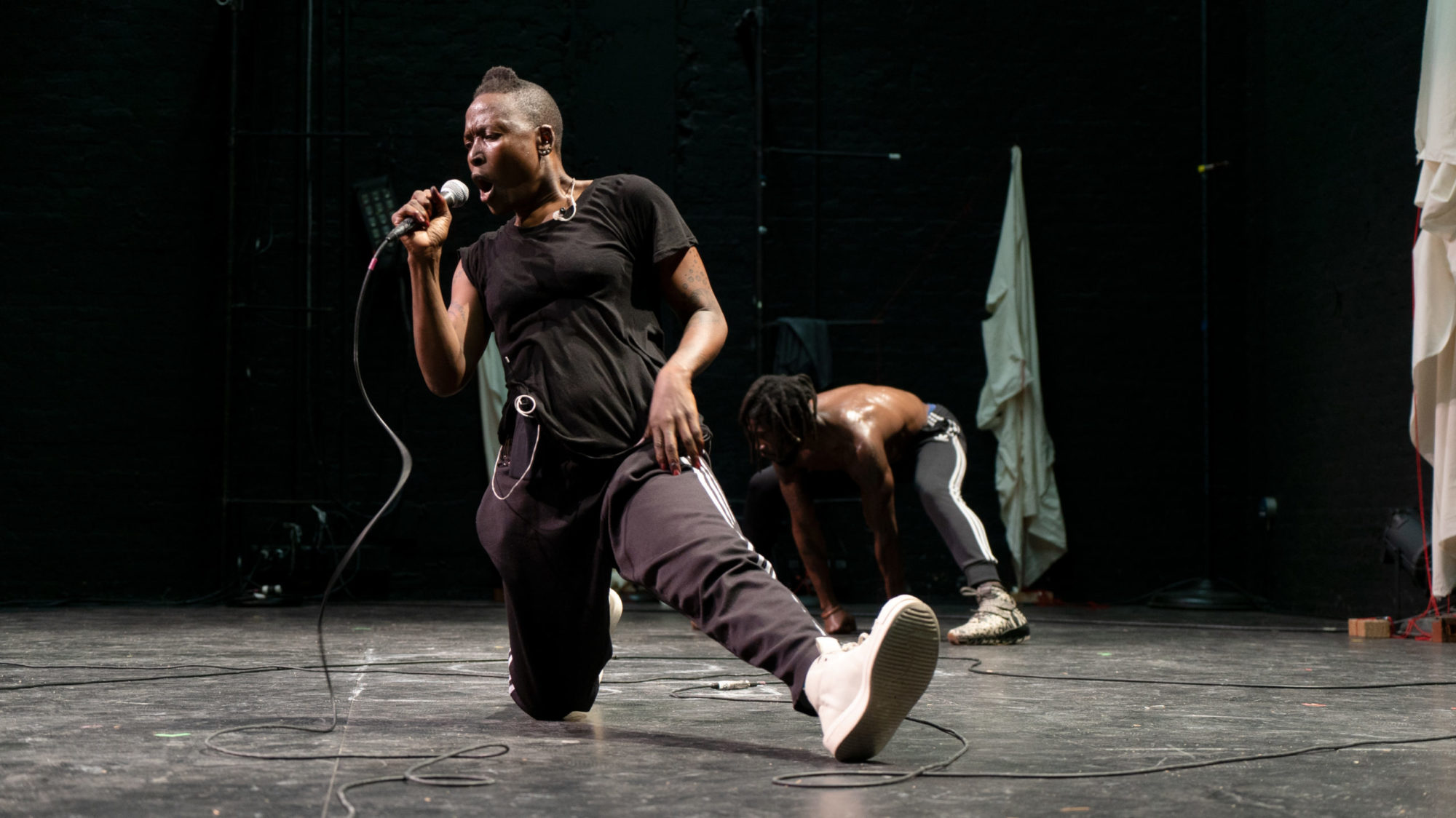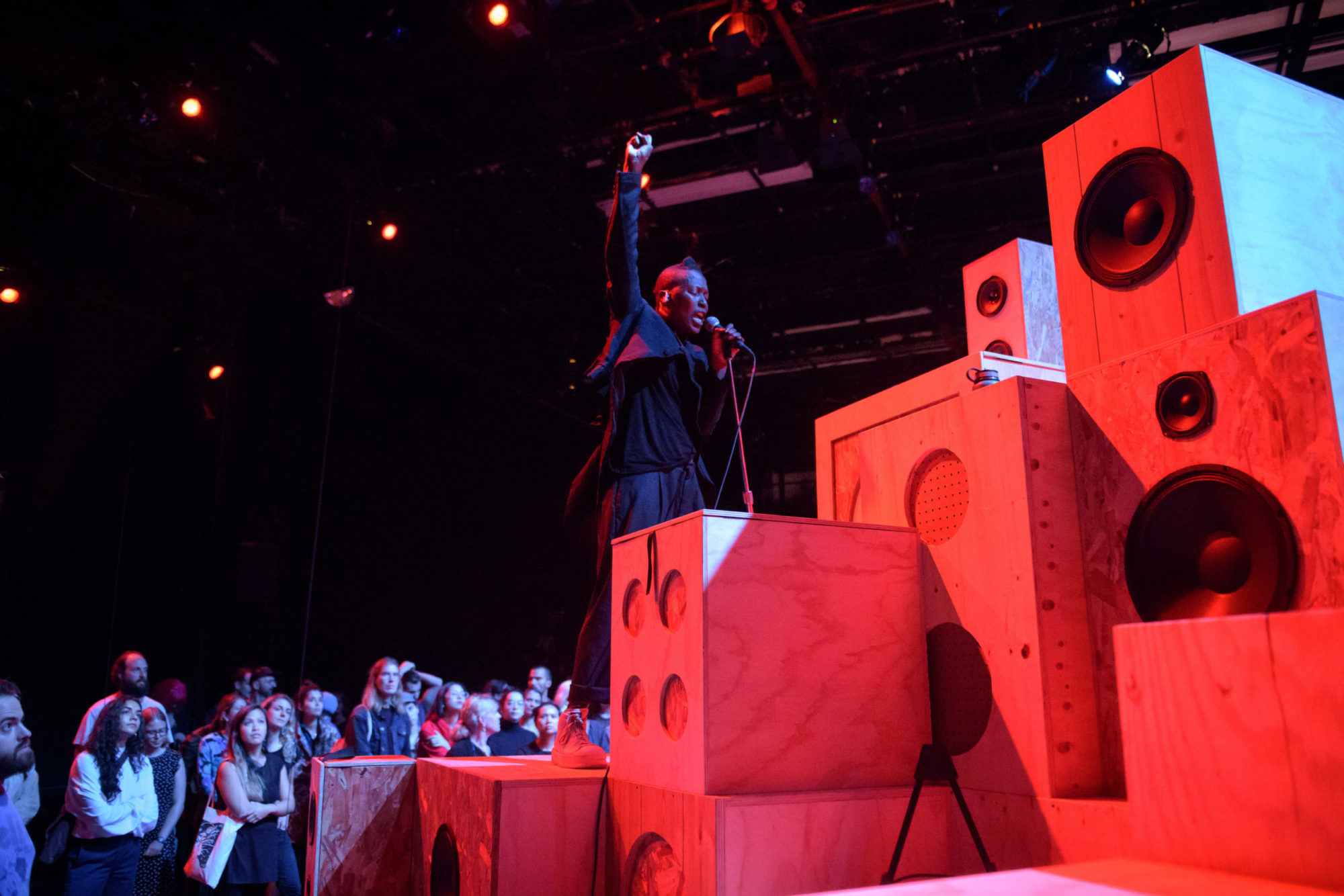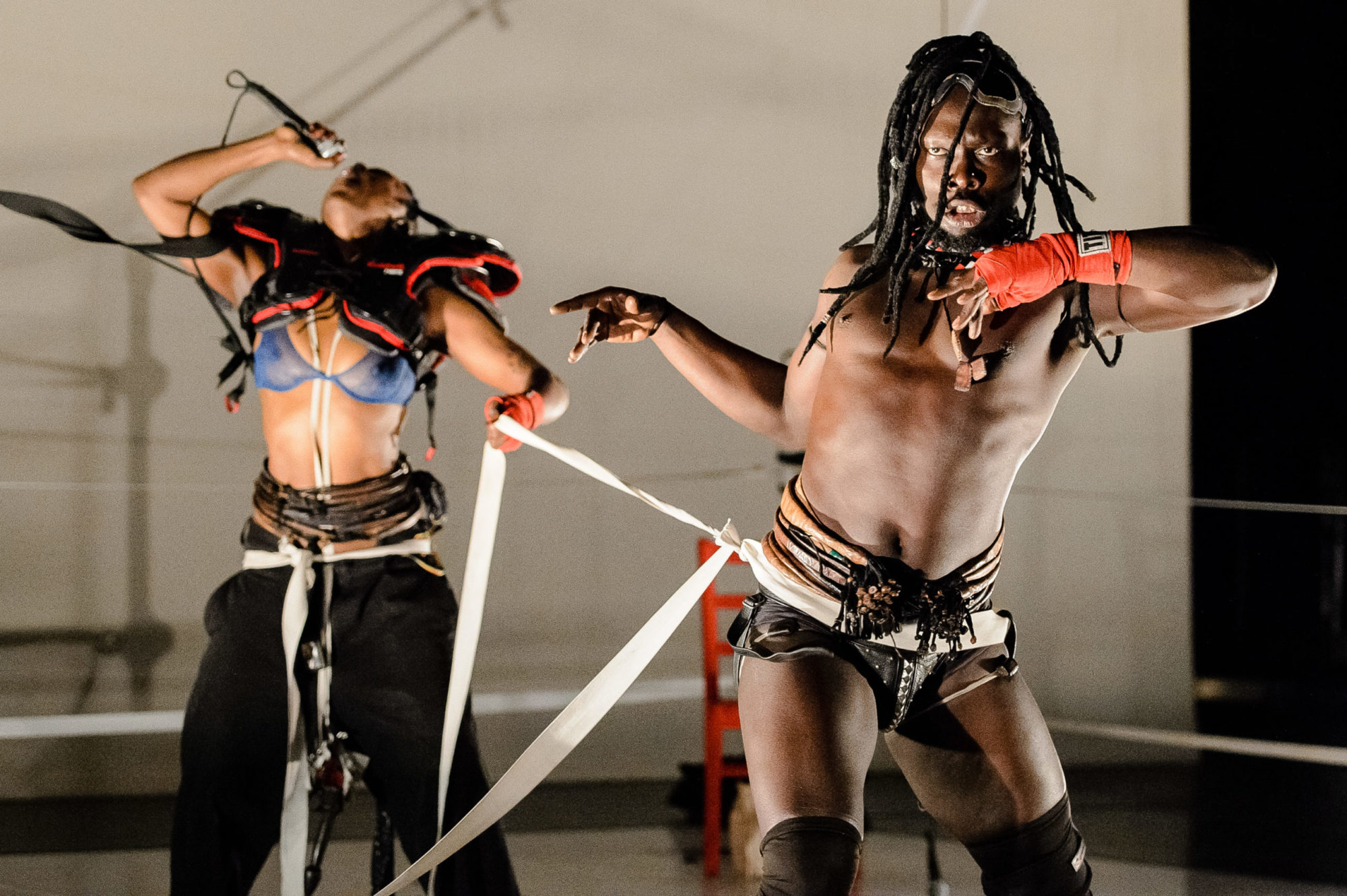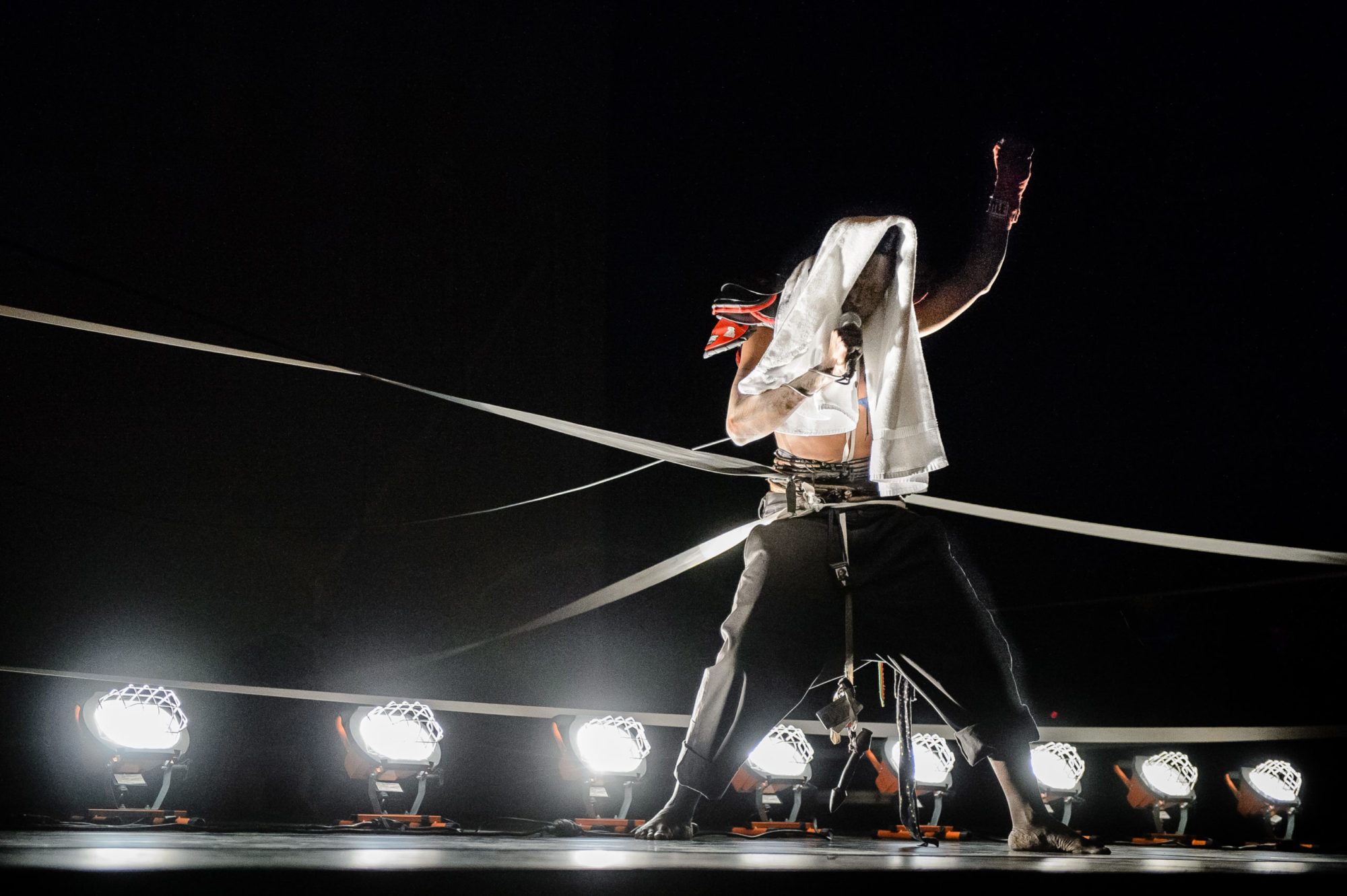nora chipaumire: Radical Space
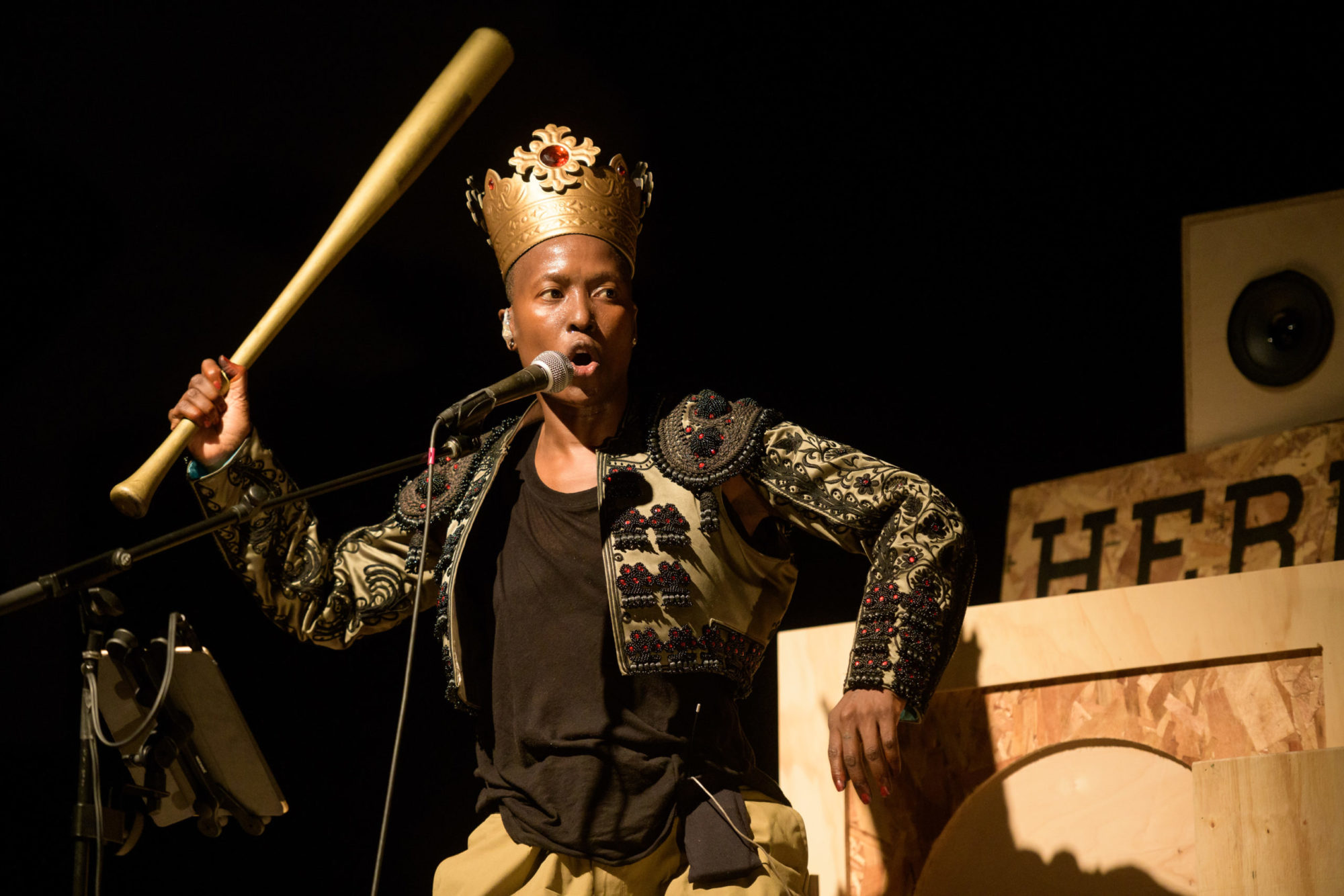
nora chipaumire, #PUNK 100% POP *N!GGA [photo: Ian Douglas; courtesy of the artist]
Share:
nora chipaumire is a performer and choreographer who uses the body—including her own—as a medium to deconstruct conditions of (in)visibility among Black African subjects. Her interdisciplinary language, which goes beyond dance and choreography, examines the structure of power at work on stage, and questions the hierarchical relationships between spectator and performer. Even amid pushing the limits of theatrical conventions such as the proscenium, chipaumire proposes new modalities of appearance and production for the Black body within performative spaces.
I met with the Zimbabwean-born, US-based artist in early March at her Brooklyn apartment, just before the coronavirus made all such proximate meetings impossible. We discussed her engagement with Western exhibition frameworks, and her critical approach to race, politics, and performance.
nora chipaumire, portrait of myself as my father [photo: Élise Fitte-Duval; courtesy of the artist]
Mathilde Walker-Billaud: I wanted to start our conversation by talking about the time we first met, in … fall 2014, when you were developing portrait of myself as my father, with the dancers Pape Ibrahima N’Diaye, aka Kaolack, and Shamar Watt. With that work, you continued your exploration of Blackness as a rich iconography, something that drove the creation of Miriam (2012)—an homage to the South African singer and activist Miriam Makeba —and underlined the creation of rite riot (2013), in which you investigate your own body and identity. In Portrait, you explored the canon of African Black masculinity through an imaginary portrait of your father. This work, which is still touring … the world, contains many grotesque gestures, costumes, and attitudes that exaggerate the stereotypical and racist representations of Black African men. How did you build a repertoire of images and gestures related to African identity, and why is this is so crucial in your exploration of the body? Can you talk about the role of visuality in your creative process?
nora chipaumire: 2014, my goodness. It is exciting to try to put order to things that are in this realm of the body and spirit—I mean to put language on how this [work] is evolving.
NC (cont.): Miriam was a way to address my mother, the overshadow of my mother, using a known figure, Miriam Makeba, who is an icon in African space. Since we are talking here about civil rights, Makeba looms large in the canon of politics of resistance. I was curious to look at the visual language around motherhood, which was very dark, as the mother is the beginning, or in the beginning there is darkness, a space where things are emerging from nothing into something. I was also very interested in the beauty of that darkness. Yesterday I was listening to Fred Moten talking about [Theodor] Adorno, saying that the palette of modernity is black! [laughs] It’s darkness! I would say that [it] is the color and the feeling of modernity. It is just black, it’s darkness, it’s this void. Black as a thing and not as nothingness. Even though I do think there is a way that we can also engage with the thingness as a nothingness.
MW-B: And you continued exploring this idea of thingness and nothingness in Portrait.
NC: Yes! What is this space that you can craft and make visible and invisible? With Portrait I was actively trying to sculpt what you can see, or what I would like for you to see, and not see.
MW-B: You played a lot with the lights in Portrait. How did you condition visibility?
NC: Yeah. With the work lights, which are an everyday work product. I was thinking about my own background: working class. My father was a teacher. For a Western mind, a teacher reads as bourgeois, or middle class, but this is not true for rural African teachers. I wanted to work with instruments such as work lights that are super bright, harsh—cold light. It is on or it is off. [laughs]
MW-B: [laughs] You definitely know when it is on!
NC: Yes, you know when it is on because it is hyper-present as light. When it is off, it is also hyper-present. You feel the absence of the light. The way I focus on the Black body is not like Arthur Jafa, who is developing ways to calibrate Black skin color with film. His major mission is to have Black skin read the way you see it in real life, the way you see me now, which is not how it reads on camera. Our work light renders the body into a black-and-white image, like a picture!
I think it was a daring choice if you are thinking of cinematography. I was not thinking of making the Black body warm and cuddly. I was thinking of making it brutally available and present, undeniably present. It is really there because you really see it, and you see the way we sweat. And the tonality of the skin isn’t as legible as if you are trying to use gels or gold, which people like to use on Black skin because that makes you more sensual. There is not sensualness to my image of the Black body. It is just a brutal object in space. I wanted to address this object, the Black body as an object. Heaving, puffing, at work!
nora chipaumire, Dark Swan [photo: Michael Winter; courtesy of the artist]
nora chipaumire, Dark Swan [photo: Michael Winter; courtesy of the artist]
MW-B: The art historian Krista Thompson, in Shine: The Visual Economy of Light in African Diasporic Aesthetic Practice, looks at the use of visual technologies by African diasporic communities. She shows how video lights are used excessively to create blinding in the making of images. She writes: “when the visual senses are inundated and exceeded, it induces a sublime state of visibility in which the subject is so hypervisible that it disappears from view.” Are you using the method of blinding to capture a subject that is fugitive?
NC: Exactly. We are blinding ourselves, as well as the public. When we do shine the light in our eyes or toward them, we are both experiencing a different time. This is similar to blindness, but [is] exquisite, ecstatic seeingness. It is kind of prophetic, if you think of Jesus, the blinding light of Jesus. [laughs] It is an attempt to open another eye. If your two natural eyes are having trouble adjusting to the light, then what other ways of seeing do you make possible?
MW-B: Excess is so important in the work. Can you talk about the way you play with excess in the performance, in the representation of the Black body? How does exaggeration contribute to this new visuality, to this new way of seeing?
NC: There is excess in the way the body is adorned. Kaolack and I wear [an] excessive amount of grigri, which is protection. You know this medicine belt that most Africans completely recognize? Most people would wear one, but we wear an excessive amount of them. What I was hoping [for was] heightening a presence of the spirit. I believe that the spirit is always present. In looking at this dramatically harshly lit body, you are also looking at the spirit. We also wear an extreme amount of eye protection, ear protection to, again, in the economy of visual language, describe a Blackness, an Africanness, exaggerate the eyes, exaggerate the ears, exaggerate the spirit, the physical presence, but also exaggerate the nakedness. For instance, Kaolack just has his grigri, his goggles, and his codpiece, but most of his costume is his Black skin. You can’t help but look at his Blackness, which pigmentation happened to be on the very deep end of the dark, almost blue-black. That’s what you are looking at for the most part!
MW-B: You present Kaolack’s body as hyper-sexualized and feminine in Portrait. Do you think the nudity of the Black body is excessive?
NC: I think a naked Black body presents a radical kind of space, especially when it is an intentional nakedness, not a nakedness because you’ve been sold in a market as a slave, or you’ve been exhibited as a boxer in a boxing ring. I started exploring the sensuality of Black skin with my Dark Swan, and then I understood this was scary territory. I was interested in how you enter in that space, like giving value, sensuousness, sensuality to a Black female body. It reoccurs in rite riot ; the female Black body in knickers and bra, in a box, to be looked [at], to be consumed. I think the African female body is the least loved of all bodies. It has the least economy value agency. I suspect that the Black African female body doesn’t even exist.
MW-B: At the end of Portrait, you carry Kaolack on your back, and say “I carry my father. I carry the carcass of my father.” That’s where you claim a space for him and for yourself, through your own body. Is this performance a way to redefine your role in your family genealogy, to make space for women in a history that is dominated by men?
NC: In portrait of myself as my father, I am also trying to claim a space for myself through masculinity, which means that there is a form of negation of the femininity, or an absence. I am wrestling with this. Would this female character exist if it was not carrying its father, brother, husband? Traditionally the woman doesn’t exist outside of her relationships to father, husband. In the absence of maleness, masculinity, maleness, not just masculinity but male presence, it seems to me that the female doesn’t exist. And I am really trying to understand this because this is something that scares me and also liberates me.
nora chipaumire, #PUNK 100% POP *N!GGA [photo: Ellen Maynard; courtesy of the artist]
MW-B: After Portrait you created the triptych #PUNK 100% POP *N!GGA, which is again a portrait of yourself through the portrait of others. This is the portrait of three women, who each represent an aesthetics and a musical genre: Patti Smith and punk, Grace Jones and pop music, [and] Rit Nzele and rumba. Are you defining here a space for yourself through femininity?
NC: Hmm. I don’t know. What is femininity through a sound space [that] is read most loudly as masculine space? I feel like we can never get away from reading confrontation as masculine. Patti Smith, Grace Jones, Rit Nzele, free radicals like me, who have to be masculine. I think what made them free is their confidence, which is not typical.
MW-B: They are standing outside any female stereotypes. You say that loudness is a space usually attributed to masculinity. Still, you use noise to claim existence for these women. Can you say more about the specificity of that loudness?
NC: It is a very calibrated loudness. It is almost a manifesto. Back to this hypervisibility, to the visual language: in the sonic performance album #PUNK 100% POP *N!GGA, I work with sound as a visual element. You see it and you hear it. You feel it kinesthetically.
MW-B: The stage [for] your performance is often dark: You don’t see well, you only hear sound. In Portrait and the triptych, you create a cacophony of voices and recordings. How do you work with this cacophony, and this unseeable sound, which is very pregnant as well?
NC: Some of that is a strategy to create volume. I am thinking again back to my working poor roots, and some strategies for survival that come out of [the] working class. What do you do when you have so little? So, the overdubbing, the oversampling, which I think is very clear in #PUNK 100% POP *N!GGA, and the repetition of the over-dubbing allows me to create that voluminous space with very little. It is not an orchestra, it is not 40 humans producing the sound. Basically it is two, three humans, but it is so extremely layered and reproduced that it takes up space. I am interested in occupying the space, making it so dense that you can even see the sound, you can almost touch it, like a fog. You can go through it. It is physically present, all around you. With hyper-sampling you would start one sound, and three seconds later, you would start the same sound. You have four gadgets essentially playing the same sound, which builds a volume. Then it starts to clash. We are very mathematical about it. When you start this new sound at an odd beat, it clashes with the previous one and visits this space where sound clashes.
nora chipaumire, portrait of myself as my father [photo: Élise Fitte-Duval; courtesy of the artist]
MW-B: Brandon LaBelle, in his book Sonic Agency: Sound and Emergent Forms of Resistance, talks about sound as a tool to rethink agency but also [as] the realm of appearance. Does clashing reorient the politics of visibility?
NC: I have been bringing other things to clash. The harsh light on the body also clashes. The sound clash is a specific methodology which is born out also of poverty: the Jamaican sound system with people repurposing speakers, rewiring them with turntables, taking popular songs, and reworking them so you would have a clash happening, and then you would have a third space, basically. But there is something physical about a clash, too, that is not only sonic, it is physical. Because when things, when sounds collide, like stars collide, you have a formation of what could be, like, a black hole!
MW-B: Do you think this space of collision is where the African female body appears?
NC: I think so. You have to create the space for the Black body. You create this space by having things clash, and almost destroy themselves in the clash. What you hear is something quite unique and different from what the origin was.
MW-B: You talked about a third space.
NC: I think #PUNK 100% POP *N!GGA is a mathematical effort. [laughs] I am very much interested in the science of our Black bodies, of this presence, the mathematics of that. There must a mathematics where clashing is a way to kind of drop into another space. Both performers and public alike, we shift ourselves in another space. I am consciously and also unconsciously trying to create this space, because I think once we get to the performance space, the presence of other bodies, and their willingness to be in the space with us at the time of the performance, starts to recalibrate the equation.
MW-B: In rite riot, you explore the stage as a place of sacrifice, but with the triptych you are going away from that idea, to create a space where you renegotiate togetherness. Is this a place of transformation?
NC: Basically once you give up your body, once you allow your body to enter … the space, this is multiplying the molecules that are in the space. Is that a sacrifice, a transformation? It is another space where we can exist together. I don’t think it’s a negotiation. I think it’s a demand, an assertion of another space. I think you are right, though, [about] the movement from rite riot, where people look up at the object, to #PUNK 100% POP *N!GGA, where people are within, where there is no separation. In fact, this is the public who are the players, with these free radicals kind of agitating, making chemistry. As a performer, I am just the agent which you pour to see what happens.
nora chipaumire, The Queen v. Nehanda (rehearsals) [photo: Jennifer Prat; courtesy Quick Center for the Arts]
nora chipaumire, The Queen v. Nehanda (rehearsals) [photo: Jennifer Prat; courtesy Quick Center for the Arts]
MW-B: With the new work The Queen v. Nehanda [still in progress], you go even further with rewriting togetherness. In this performance space everyone will be participating, enacting a historical episode: the trial of the leaders of the first liberation war against the colonization of Zimbabwe in the late 19th century.
NC: The Queen v. Nehanda is an immersive opera about the people who don’t have, who are considered extralegal. Africa exists as outside of the law, which is why it could be colonized. It had no owner. I am trying to understand the colonial project as an attempt to make legal, to bring into lawfulness, that which was unlawful. The work is about the murder of early resisters to colonialism. These resisters were found guilty according to British law. But what is British law in an African space? Together with a public we will come to this space of legal discourse. The public and the players are judges, jury, philosophers, lawyers, solicitors, researchers. We are all in this space, which is a liminal space. Let’s say we are in a spaceship just floating around in space.
MW-B: A third space?
NC: An alternative space. We are trying to understand and research what is law, who has jurisdiction over whom. Under … Queen Victoria, the British Empire was rising, using law to acquire more territories, more subjects. So, the creation of subjecthood has to do with the law.
MW-B: So, there were no subjects before … Queen Victoria came [into] Africa? It was the void!
NC: The void, just simply. It was just dark with unruliness, chaos. By the time we get to the Berlin Conference in 1884, Africa has already been read as a nothing space, which needs to be organized and disciplined, and given law! [laughs]
You can kind of track where I am coming from with this nothingness of the Black body. It is loud, chaotic, needs to be given light for visibility, needs to be given another space to exist.
MW-B: To understand this space, you are going to explore what pre-existed and can co-exist with the British institution, such as Shona mythology?
NC: What does exist instead of this? My project demands of me to understand what was there in that nothingness, what is read by Europe as nothingness. Nehanda, this other sovereign that I am talking about, is a spirit, it is not a human. It is a spirit that occupies humans, that comes to life through humans in different epochs. It is a living spirit. What I am trying to get [at] is what is that other thing, that maybe was and could it be again, and if it could be, then do we arrive at the new Black body? What is that Black body that has agency, legitimacy, law, rules of law, jurisdictions outside the White universe?
MW-B: In 2014, when I met you, I invited you to be part of my series of screenings and lectures, What You Get Is What You See, a forum about spectatorship at UnionDocs. During your talk, you questioned the notion of spectatorship, arguing that it was a Western tradition, and you compared the spectator to an expatriate. Is it possible to have performance, to have spectatorship without a White gaze or space?
NC: This exterior gaze gives me the right to exist. Almost without that gaze, I don’t exist. I am lucky to have these conversations with you over periods of time to see how we keep returning to this question. It is fundamental to what I am doing, maybe the only question that I am asking.
